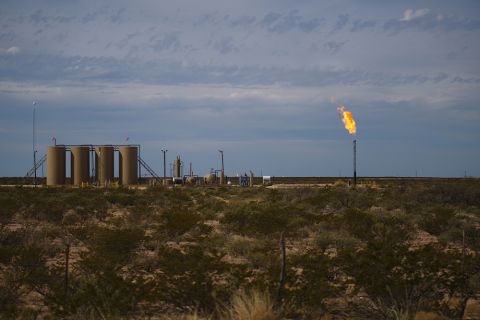
SBM’s extensive floating production and mooring expertise has been brought to bear on its floating wind turbine design, now chosen by EDF-EN for a pilot project offshore France. (Source: SBM Offshore)
The growing number of offshore companies seriously stepping up their interest and activities in the expanding renewable energy sector is no accident.
For many this process has been accelerated by the horrendous downturn that has decimated the upstream oil and gas sector, spelling out for the survivors in no uncertain terms that they need to diversify their offerings and targeted markets. It’s not simply a PR gimmick to appease environmentally aware investors and the general public. In most cases it makes sound business sense, both for today and in the inevitable long-term future.
A broad energy portfolio over the next several decades will be the answer to supplying the world’s continuing growth for more fuels as no one sector is remotely able to meet the majority of that demand on its own.
Major operators like Eni and Statoil, for example, have long recognized the need to be involved in this sector. Eni is undoubtedly the upstream industry’s star performer in terms of its conventional oil and gas success of the past two years or so, with major discoveries like its giant Zohr gas field offshore Egypt rapidly being fast-tracked toward production later this year.
Renewables focus
But Eni is not doing this at the expense of renewables. The company signed an agreement with GE in November 2016 to develop renewable energy projects and hybrid solutions with a focus on energy efficiency.
The companies intend to jointly identify and develop large-scale power generation projects from renewable energy sources, covering technologies within offshore and onshore wind generation, solar power, hybrid gas-renewable projects, electrification of new and existing assets, waste-to-energy projects, the “green” conversion of mature or decommissioned industrial assets, and the deployment of technologies developed by Eni’s R&D department.
Eni, which has been operating in the renewable energy sector since 1980, said this deal is part of its ongoing strategy to develop renewable sources by leveraging the industrial and commercial synergies of its traditional activities.
Statoil’s Hywind project
Statoil is following the same approach, particularly with regard to its offshore expertise. Its lead role in developing what will be the world’s largest floating windfarm offshore Scotland, the Hywind project 25 km (15.5 miles) off the coast of Peterhead, should be operational by late 2017. The project will see five 6-MW turbines supplied by Siemens placed in 100 m (328 ft) of water in the U.K. North Sea generating electricity, following on from the successful trial of a single 2.3-MW floating turbine the operator has had up and running offshore Norway since 2009 in 220 m (722 ft) of water. Siemens also supplied that Hywind Demo turbine, with the 100-m deep draft floating cylindrical steel spar built by Technip.
The technology is relatively simple, with each of the new Hywind project’s installations to be a similar spar buoy moored by three steel catenary cables to suction cup anchors. Hywind will use a ballasted catenary layout that adds 60-tonne weights hanging from the midpoint of each anchor cable to provide additional tension.
This is not a small-scale token gesture of a project—Statoil will invest about NOK 2 billion (US$233 million) in Hywind Scotland while also pointing out that it still remains essentially a pilot project that could be a forerunner to a much larger scale development depending on its performance and economic findings.

Supply chain experience
The importance of being able to dip into an experienced oil and gas supply chain to design, build and deliver this kind of project will be a key factor in the early success of such pioneering ventures. Offshore veteran Saipem, for example, has been contracted by Statoil to carry out the lift and mating operations for Hywind Scotland.
The vision of floating flotillas of turbines far from shore in water depths and strong winds beyond the reach of seabed-fixed turbines is an enticing one for offshore players, whether constructing, installing, maintaining or decommissioning them. It’s a natural extension of what they have been doing for decades.
The market is relatively small at present, with offshore wind making up just 3% of all wind power, but most observers believe it can only continue growing, especially as countries such as Japan, China, the U.K. and U.S. are increasing their wind power ambitions.
Production enhancing
In addition, wind is seen as something that can be reapplied back to the oil and gas sector. Companies such as DNV have flagged the possible efficiencies and production- enhancing benefits of placing wind turbines on new and existing field facilities.
A study released in early 2016 by the classification society calculated that in some cases a floating wind turbine instead of a gas turbine could economically provide power for water injection to boost oil production from depleting reservoirs without the need to shut down production and also would reduce fuel costs. DNV, along with study partners including ExxonMobil, estimated savings of about $3/bbl of oil using a 6-MW Hywind instead of traditional engines to power a pair of 2-MW water injection pumps into an offshore well. This would be economically viable, DNV said, at step-out distances of up to 30 km (18.6 miles).
Turbine power capacities also are continuing to rise, with those installed offshore in 2013 averaging 4 MW, while today’s projects under development are in the 6 MW to 7 MW range. DNV said turbine size will increase over the coming decades, stating that some developers expect 10-MW offshore turbines to be commercially available in the early 2020s.
Familiar floaters
The various options for the substructures are all very familiar to offshore contractors, with the three main designs currently in play being spars, semisubmersible units and tension-leg platforms, all of course being much smaller scale than those used in offshore oil and gas production designs so far.
This is where companies such as Technip and SBM Offshore come in. The latter’s field-proven floating production and mooring technologies are directly applicable, and this was recognized by France’s EDF-EN for a government- backed offshore wind pilot project underway.
SBM was picked to potentially supply three floating wind systems to sit in 100 m of water off the coast of Marseilles, France. Again, this is no sudden and reluctant entry into the renewables sector by an oil and gas player. The company’s technology arm has been working for more than a decade on its offshore renewable energy offerings, mostly focused on floating wind power, wave and tidal energy, and ocean thermal energy conversion. As it points out in its renewables literature, “Half of the world’s population lives within 60 km [37 miles] of the coastline, making it a natural match for energy supply and demand.”
Lightweight solution
The work for EDF-EN came via its ongoing technical development collaboration with the French research and innovation organization IFPEN.
SBM’s lightweight floating wind turbine solution features an inclined taut mooring arrangement that minimizes motions at the level of the nacelle. SBM said the inclined legs create a fixed point close to the nacelle location, minimizing the accelerations and motions of the nacelle to decrease the loading on the turbine and mast as well as helping to optimize power output. The inclined legs also reduce the tension in the mooring lines both in operational and extreme cases, the company added.
The floater and its mooring system have been successfully tested in a model basin at 1:40 scale, with the design compatible with horizontal-axis and vertical-axis wind turbines.
An optimized installation process would feature a wet tow to site with the wind turbine generator installed, meaning full quayside integration. The construction of the structure using smaller components also means that they can be built at different locations to optimize costs, schedule and local content requirements.
If the project receives the eventual final investment decision, SBM will deliver the modular floating systems and mooring components on a turnkey engineering, procurement, construction and installation basis. The project is in the pre-FEED stage.
Floating wind farms remain a solution still in their early stages, but much of the initial cynicism about their economics is fast disappearing thanks to encouraging early performances by various pilot projects off Norway, Italy and Portugal and—more latterly—offshore Japan. As costs continue to come down through natural design improvements and their competitiveness compared to onshore and fixed offshore installations grows, the wind looks to be blowing in the right direction for floating turbines.
Recommended Reading
EQT CEO: Biden's LNG Pause Mirrors Midstream ‘Playbook’ of Delay, Doubt
2024-02-06 - At a Congressional hearing, EQT CEO Toby Rice blasted the Biden administration and said the same tactics used to stifle pipeline construction—by introducing delays and uncertainty—appear to be behind President Joe Biden’s pause on LNG terminal permitting.
Pembina Pipeline Enters Ethane-Supply Agreement, Slow Walks LNG Project
2024-02-26 - Canadian midstream company Pembina Pipeline also said it would hold off on new LNG terminal decision in a fourth quarter earnings call.
Williams Beats 2023 Expectations, Touts Natgas Infrastructure Additions
2024-02-14 - Williams to continue developing natural gas infrastructure in 2024 with growth capex expected to top $1.45 billion.
Waha NatGas Prices Go Negative
2024-03-14 - An Enterprise Partners executive said conditions make for a strong LNG export market at an industry lunch on March 14.
Enbridge Announces $500MM Investment in Gulf Coast Facilities
2024-03-06 - Enbridge’s 2024 budget will go primarily towards crude export and storage, advancing plans that see continued growth in power generated by natural gas.





